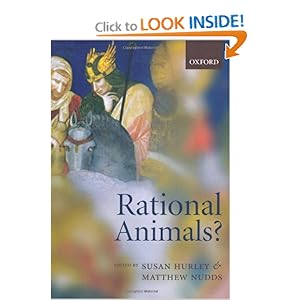 |
| φωτο Αmazon |
Susan Hurley/ Matthew Nudds (eds): Rational Animals (Oxford 2006)
Part VI: Behaviour and Cognition in Symbolic Environments
Chapter 20: Louis M. Herman: Intelligence and Rational Behaviour in the Bottlenosed Dolphin
Μπορείτε να διαβάσετε ολόκληρο το κεφάλαιο εδώ.
Abstract
A rational animal is defined as one that can perceive and represent how its world is structured and functions, and can make logical inferences and draw conclusions that enable it to function effectively and productively in that world. Further, a rational animal is able to incorporate new evidence into new perspectives of the world and can then modify its behaviours appropriately -in effect creating a new or revised model of the world in which it is immersed. Rational behaviour is necessarily built on the bedrock of general and specific intellectual capacity. Intelligence, a multidimensional trait, may appear to various degrees in various behavioural, cognitive, or social domains. Data and observations are presented on dolphin cognitive performance and on apparent rational responses within four intellectual domains within the context of a variety of empirical studies that we have conducted. These domains are: a) the declarative (semantic or representational) domain (does the dolphin display knowledge or understanding about things?); b) the procedural domain (does the dolphin exhibit competency in means, operations, or methods?); c) the social domain (does the dolphin reveal social awareness and appropriate responsiveness in social interactions or relations?); and d) the domain of the self (does the dolphin exhibit knowledge or awareness of itself?). In each case, the particular experimental paradigms are briefly outlined and instances of apparent inferential or creative acts within each paradigm are given.
Δεν υπάρχουν σχόλια:
Δημοσίευση σχολίου